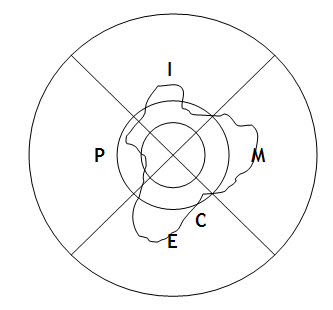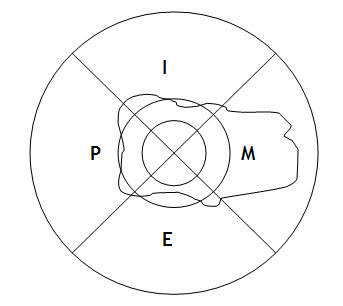In the last blog a model of absolute and relative poverty was developed, leaving plenty of space over for varying states of prosperity to be recorded. All of which then begs the question, where am I on this diagram? Am I achieving, or not?
I think this can be plotted, but I would add straightaway that this plotting is subjective. It might be done by the individual themselves. It could be done by someone else. In either case the result is subjective because the criteria for assessment will always be subjectively chosen in the first place.
This plotting process is helped by a desirable characteristic of a circle, which is that it offers an infinite number of radii that can be drawn within it. The reality is that out of the enormous range of choices available we will choose a very limited range of options to try. That is one of the characteristics of being constrained, if only by time, which this model explicitly recognises. For each option that we try a radius could be drawn from the centre of the circle indicating the range of achievement we had reached. Analysis could be done on those choices. I am not pursuing that line of thought now. Instead, I want to draw a line joining a person’s achievements together. This becomes their area of achievement. It might look like this (and is described as C, the consequence of actions):

This is a person who is materially sufficient: they have enough to live on. They are largely emotionally satisfied. They have only two areas of relatively limited emotional concern. Their intellectual life is constrained, but only partly. They are however suffering a substantial lack of purpose and this is creating a serious threat to their well-being because they have moved into an area of absolute deprivation.
This situation is easy to translate to the reality of life as we see it. There are very many people who are materially well off and emotionally supported and who can apparently interact with society perfectly well who are nonetheless in crisis. The indication of this malaise in a person’s spiritual well being is relayed through anxiety, stress and ultimately the threat off or actual practice of suicide.
The importance of the model presented here is immediately easy to see. Conventional economic models only relate to material well-being. This model defines well-being in a very different fashion whilst (as I will show in due course) being able to handle the issues that a conventional economic model addresses. The implications will be explored later. The importance should be noted now.
What the model lets us do is assess relative well-being with comparative ease. For example, this person’s life is obviously unbalanced:

They are clearly materially well off. They have very poor social relationships despite that. It may well be that their sense of meaning is diminished as a result.

Again, with caveats raised earlier, I like this model.
Time will naturally tell if, however, it can serve as the basis of something we can call economics.
In the meantime, a pedantic point:
“Begs the question” is usually employed by techicians in analytic traditions to me “assuming as a premise the conclusion which is being argued for”.
What I think you mean is “raises the question”.
Pedantic…but then, I’m a pedant.